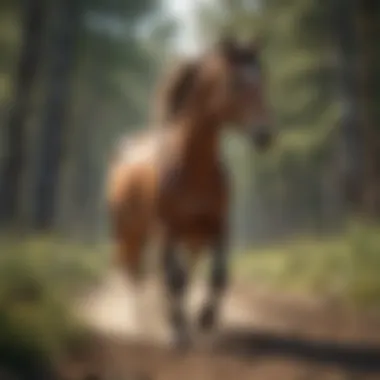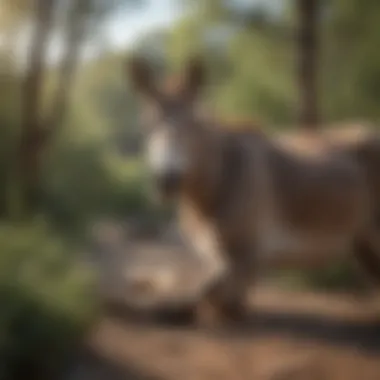The Wild Horse and Burro Program: An In-Depth Analysis


Intro
The Wild Horse and Burro Program is an essential framework dedicated to the management and protection of free-roaming horses and burros in the United States. Established in response to serious ecological concerns and the need for humane treatment, it navigates a complex landscape of challenges. These challenges include population control, habitat preservation, and addressing public perception of these iconic animals.
This analysis focuses on the program’s intricacies, exploring its history, the regulatory framework guiding its operations, various management methods, as well as the cultural significance these animals hold in American society. It further delves into the ongoing debates surrounding the program, offering insights into future directions that can enhance effective management practices.
Understanding Wild Horse and Burro Ecosystems
Importance of Biodiversity in Wildlands
Biodiversity in ecosystems where these animals roam is crucial. Healthy populations of plants and animals create a balance in the environment. Wild horses and burros can both positively and negatively impact plant life, depending on their population density. Managing their numbers can help maintain this balance while promoting healthy habitats.
Role of Temperate Ecosystems in Environment
The ecosystems where wild horses and burros thrive also play significant roles in climate regulation. These habitats often provide carbon storage and can affect local weather patterns. By understanding these dynamics, management strategies can be developed to ensure the sustainability of both the animals and their habitats.
Challenges in Managing Wild Horse and Burro Populations
Population Control Methods
Effective population control measures are fundamental to the program. These measures include:
- Fertility Control: Using immunocontraceptive vaccines to manage birth rates among wild populations.
- Adoption Programs: Encouraging the public to adopt untrained horses or burros to reduce population size.
- Roundups: Conducting humane roundups to relocate excess animals to adoption facilities or designated habitats.
"The delicate balance between maintaining wild populations and protecting their habitats is a continuous challenge."
Habitat Preservation Efforts
Preserving adequate habitats is equally important. This involves protecting these areas from development and ensuring sustainable grazing patterns. Organizations often collaborate with local communities to resolve conflicts between livestock grazing and wild animal populations.
Cultural Significance of Wild Horses and Burros
These animals hold profound cultural significance in American history. They symbolize freedom, strength, and resilience. Understanding this cultural aspect enriches the narrative surrounding the program. Many advocates stress the need to honor this heritage while seeking solutions to conservation challenges.
Future Directions for Effective Management
As the program evolves, it must adapt to new challenges that arise. Future approaches could include:
- Leveraging technology to monitor horse and burro populations more accurately.
- Enhancing community engagement through educational programs aimed at increasing awareness of wild animal management.
- Collaborating with various stakeholders, including environmental groups, ranchers, and local governments, to create comprehensive strategies that address ecosystem health and animal welfare.
In summary, the Wild Horse and Burro Program faces numerous challenges but also presents opportunities for innovative management that respect both the animals and the environments they inhabit.
Prelims to the Wild Horse and Burro Program
The Wild Horse and Burro Program represents a critical effort in the management and preservation of free-roaming horses and burros in the United States. These animals have significant historical and cultural relevance, providing not only a glimpse into America's past but also a challenge in contemporary wildlife management. As populations of these animals have increased over the years, so have concerns about their impact on ecosystems, agriculture, and local biodiversity.
The program is essential for balancing ecological stability and the humane treatment of these equine species. This section will delve into the background and rationale for the program, outlining the necessity of such measures in light of the socio-ecological challenges these animals face.
Background and Rationale
The background of this program lies within the dual recognition of horses and burros as both culturally significant and ecologically impactful. The presence of feral horses and burros in North America is a relatively recent phenomenon, occurring largely after European settlers arrived. Their numbers soared without natural predators, leading to overpopulation in many areas.
Ecological rationale plays a significant role in the establishment of the program. Research indicates that these animals can have detrimental effects on vegetation, soil stability, and the overall health of local ecosystems. As they compete for resources with native species, their unchecked populations could lead to a decline in biodiversity and habitat degradation. Thus, the program emerged not only as a way to manage these animal populations but also to foster healthier ecosystems across the regions they inhabit.
Purpose and Goals of the Program
The primary purpose of the Wild Horse and Burro Program is to manage free-roaming populations in a way that ensures their survival while maintaining ecological balance. The program aims to achieve several goals:
- Population Control: Implementing effective management strategies to prevent overpopulation of horses and burros.
- Habitat Preservation: Ensuring these animals do not adversely affect their environment, thereby protecting the habitats of many native species.
- Adoption and Placement: Encouraging the adoption of excess animals to promote humane outcomes.
- Research and Data Collection: Gathering scientific data to inform better management practices and ecological strategies.
Overall, the program emphasizes humane treatment and sustainable practices that benefit both the animals and the ecosystems they inhabit. This balanced approach is vital as it addresses both conservation needs and the ethical implications of managing free-roaming equine populations.
Historical Context
Understanding the historical context surrounding the Wild Horse and Burro Program is critical. This provides clarity about not just the program itself but also the deep-rooted issues regarding the management and preservation of these animals in their natural habitats. The interactions between humans, horses, and burros in North America have evolved over centuries. These changes have often dictated how these animals are perceived, managed, and treated. Moreover, the historical factors that led to the establishment of this program are paramount to comprehend the current legal and management strategies. As the program navigates contemporary challenges, a solid grasp of its past can illuminate future directions and decisions.
The Arrival of Horses and Burros in North America


The introduction of horses and burros to North America marks a significant chapter in the continent's ecological evolution. Horses were brought by Spanish explorers in the 16th century. They transformed transport and changed indigenous cultures. Considering that burros arrived around the same period, their role was also notable. Originally, they served as pack animals, facilitating transportation of supplies across vast terrains. Over time, both species formed wild populations, adapting to the American landscape. By the 19th century, as settlers expanded westward, these animals became symbols of freedom and resilience, also complicating existing ecosystems.
The emergence of extensive feral populations altered the landscapes they inhabited. It's essential to investigate how these dynamics led to both admiration and conflict between wild horses, burros, and their environments. Their presence began to affect vegetation, soil stability, and interactions with native wildlife. A growing recognition of these impacts prompted debates about their roles in the ecosystem and humanity’s responsibility towards them. Thus, the narrative of horses and burros in North America is not solely about their utility but also speaks to the challenges of coexistence within diverse ecosystems.
Legislative Developments Leading to the Program
The legislative backdrop of the Wild Horse and Burro Program can be traced to a series of pivotal laws that sought to regulate and protect these animals. In 1971, the Wild Free-Roaming Horses and Burros Act established the legal framework for their protection. Legislators recognized that free-roaming horses and burros were becoming increasingly threatened by encroachments from human activities. This prompted the need for a policy that balanced environmental concerns with the plight of these animals.
The Act was a response to the significant decline of wild horse populations due to excessive predation, habitat destruction, and mismanagement. It declared these species as living symbols of the historic and pioneer spirit of the West, thus enshrining their protection in law. The law also underscored the notion that managing these populations was not simply an ecological consideration but also a cultural and historical imperative.
Since its inception, the Act has undergone several amendments and revisions, adapting to the evolving challenges of population management and ecological health. Additionally, legislative actions, such as the Appropriations Act, have played a crucial role in determining funding and resources allocated to the program. A thorough investigation into these legislative developments is essential for understanding the complexities facing the Wild Horse and Burro Program today.
Legal Framework
The legal framework governing the Wild Horse and Burro Program is crucial to its success and sustainability. It provides the necessary structure and regulatory guidelines that help manage wild horses and burros within the United States. This framework establishes the responsibilities of various stakeholders and sets the foundation for ethical treatment, conservation efforts, and population management.
Underpinning the program is a series of legal statutes that inform how wild equines are to be treated and managed. This legal backdrop helps to ensure that all actions taken are in compliance with federal and state regulations. Importantly, it also addresses how to mitigate conflicts that may arise among stakeholders, including land managers, animal welfare advocates, and the public.
The legal structure ultimately aims to balance conservation efforts with the need for effective population control, considering ecological impacts and the well-being of both animals and ecosystems.
Key Legislation Impacting the Program
The cornerstone of the Wild Horse and Burro Program is the Wild Free-Roaming Horses and Burros Act of 1971. This act was a significant legislative response to growing concerns about the diminishing populations of these animals in the wild. It establishes protections for wild horse and burro populations, recognizing their historical significance and contribution to American culture.
The Act designates specific lands as territories for these animals, prohibiting their harassment and capturing without proper permits. Furthermore, it emphasizes the importance of maintaining a sustainable population through appropriate management practices. The Bureau of Land Management (BLM) and United States Forest Service (USFS) are tasked with enforcing the provisions laid out in this Act.
Other key legislative developments include amendments and policies that have evolved since the original Act. For instance, the BLM's standard operating procedures integrate principles of environmental stewardship and animal welfare into daily operations. These amendments aim to improve the management effectiveness while addressing various challenges faced by the program.
Administrative Oversight and Responsibilities
Administrative oversight is another critical aspect within the legal framework of the Wild Horse and Burro Program. The roles and responsibilities of federal agencies, particularly the BLM and USFS, are well-defined. They are entrusted with the management of wild horses and burros on public lands, ensuring compliance with existing regulations and addressing welfare issues related to these populations.
The agencies are responsible for implementing population management strategies, including removals, adoptions, and monitoring of herd health. They work in collaboration with stakeholders, including local communities, conservation groups, and researchers, to refine practices and adapt policies based on new findings.
Challenges often arise in effectively communicating with stakeholders about management goals and practices. Transparency in decision-making processes is essential to build trust and ensure that various viewpoints are considered. This collaborative approach is designed to create favorable outcomes, both ecologically and socially.
Population Management Strategies
Population management is crucial for the Wild Horse and Burro Program. Effective strategies ensure the sustainability of this iconic species while addressing the competing interests of land use, ecology, and public perception. Without a clear management plan, the wild horse and burro populations can exceed the carrying capacity of their habitats, leading to detrimental environmental impacts.
Gathering and Adoption Practices
Gathering wild horses and burros is a necessary method to control population numbers. The techniques employed vary. Helicopter gathers are often used to move larger groups quickly. These practices are conducted with care to minimize stress on the animals. Once gathered, these animals undergo a process of adoption where they can find new homes.
The adoption program is a vital component of population management. It not only reduces the number of free-roaming animals but also provides a new life for them in captivity. Adopters receive training on how to care for the animals, which enhances the success rate of adoption. Overall, gathering and adoption practices serve as a bridge between wild populations and responsible ownership.
Fertility Control Research and Implementation
Fertility control is a progressive approach for managing wild horse and burro populations. Studies have focused on various methods, including the use of vaccines. These vaccines can reduce fertility rates in the wild populations. This research is significant because it offers a humane alternative to more invasive measures.
The implementation of fertility control is not without challenges. Monitoring populations after vaccination is essential for understanding the effectiveness of these measures. Therefore, continual research is necessary to adapt and improve fertility control practices.
Ecological Considerations for Herd Management
Ecological considerations form the backbone of effective herd management. Understanding the balance of ecosystems in which these animals reside is critical. Overpopulation can lead to overgrazing, soil degradation, and loss of native flora and fauna. Therefore, herd management strategies should always align with ecological health.
Managers must assess the land's carrying capacity and its ability to support wildlife. This requires a comprehensive analysis that includes soil health, water availability, and interactions with native wildlife. Adjustments to herd sizes and management practices can enhance ecological balance and sustainability.
Responsible population management integrates animal welfare with ecological integrity, ensuring a future for both the wild horses and their habitats.
Economic Implications


The examination of economic implications related to the Wild Horse and Burro Program is crucial for understanding the broader impacts on society and the environment. This section dissects the costs associated with the program as well as the sources of funding and the financial challenges it faces. Recognizing these factors can illuminate how the program operates and its viability moving forward.
Costs of Management and Operations
The management of wild horses and burros incurs significant costs. These costs can be categorized into several areas:
- Gathering and Employing Resources: Regularly, the Bureau of Land Management (BLM) must gather wild horses and burros to maintain population levels. The resources required for these gather operations include equipment, personnel, and logistics, which can add up quickly.
- Care and Maintenance: Once the animals are gathered, they require care and maintenance. This includes feeding, veterinary care, and housing, which can impose continuous expenses on the program's budget. The daily care of thousands of animals is a substantial financial burden.
- Adoption and Public Outreach Costs: To facilitate the adoption process, the program invests in marketing and outreach initiatives. These efforts aim to educate the public about responsible adoption practices, bringing more families to consider adopting a wild horse or burro.
Ultimately, all these operational costs present a direct influence on how effectively the program can achieve its goals, leading to ongoing evaluation of budget priorities.
Funding Sources and Budgetary Challenges
Funding for the Wild Horse and Burro Program comes from various sources, each of which has its own set of challenges and limitations.
- Congressional Appropriations: A significant portion of funding relies on annual allocations from Congress. As budget priorities change, the program often finds itself competing against other initiatives for these limited funds.
- Partnerships and Grants: The program also secures funding through grants and partnerships with non-profits and other organizations. While these partnerships can provide crucial financial support, they are sometimes unpredictable and depend on fluctuating funding sources.
- Adoption Fees: Revenue from adoption fees contributes to the program's budget. However, this source relies on the public's willingness to adopt, making it somewhat unstable.
Budgetary challenges are exacerbated by increasing operational costs and legislative constraints on how funds can be utilized.
"Understanding the economic implications of the Wild Horse and Burro Program is essential for its long-term viability."
It is evident that without a steady financial commitment and innovative thinking regarding funding sources, the ability to sustain the program may be at risk. The economic health of the program directly impacts both management effectiveness and the welfare of the horses and burros. Faced with these challenges, the program must continuously adapt its strategies to ensure long-term sustainability.
Ecological Impact
The ecological impact of the Wild Horse and Burro Program is of paramount importance. This aspect directly influences not only the management of these animals but also the broader ecosystems where they exist. Understanding the ecological consequences of wild horses and burros on their surroundings offers insights into sustainable practices that can benefit both the species and their environments.
Effects of Wild Horses and Burros on Landscapes
Wild horses and burros are often considered keystone species within their habitats. They play a significant role in shaping the landscape through their foraging habits. Grazing can lead to changes in vegetation patterns, which impacts the availability of food and shelter for other wildlife. Overgrazing, however, leads to soil erosion and degradation of plant life.
- Nutrient Cycling: Their movement across landscapes can enhance nutrient dispersal. They contribute to the recycling of organic material, which can improve soil health in some areas.
- Water Sources: Wild horses and burros often congregate near water sources, which can lead to increased trampling around these areas. This can adversely affect water quality, compounding issues like sedimentation and contamination.
- Habitats Alteration: Changes in the plant community due to grazing pressure affect not just vegetation but also the diversity of the overall habitat. This can result in less resilience within the ecosystem when facing environmental changes.
While wild horses and burros can positively influence biodiversity, their uncontrolled populations can lead to significant landscape challenges.
Interactions with Native Wildlife and Habitat
The interactions between wild horses and burros and native wildlife are complex and sometimes contentious. Their presence can lead to competition for resources, especially between them and native herbivores. This can exacerbate the decline of species that are already endangered or vulnerable.
- Resource Competition: Both wild horses and burros compete for forage and water with native species such as deer and bighorn sheep. This competition can severely affect the populations of these native species.
- Disruption of Ecological Balance: The trampling of soil and plants by large numbers of wild horses can disrupt established plants and habitats that are essential for local wildlife.
- Potential Benefits: In some instances, their grazing habits can create new habitats for certain species. By maintaining open spaces, they can facilitate the growth of some plant types that benefit other wildlife.
Understanding these interactions is essential for forming effective management practices that strike a balance between protecting wild horses and preserving native ecosystems.
Cultural and Social Perspectives
The Wild Horse and Burro Program does not only focus on ecological and management strategies; it also recognizes the profound cultural and social implications tied to the presence of wild horses and burros in the United States. These animals are not just part of the landscape; they possess historical significance and evoke strong sentiments among various community groups. Understanding this dimension is crucial for a comprehensive view of the program and its challenges in preserving these iconic species.
Cultural Significance in American History
Wild horses and burros are emblematic of American frontier history. The arrival of these animals transformed the lives of Native Americans, early settlers, and ranchers. Horses enabled mobility across vast terrains, revolutionizing transportation, work, and even warfare. Burros, often viewed as the hardiest of pack animals, carried supplies and miners during the Gold Rush. This historical context imbues them with a sense of nostalgia and reverence in the American consciousness.
Moreover, the image of the wild mustang galloping freely across the plains represents ideals of freedom, adaptability, and resilience. This cultural narrative is cherished and upheld by many, reinforcing the need for protective measures given the threats posed to their populations.
"The wild horse is a symbol of American independence. Their lives mirror the spirit of the land they roam."
The cultural importance also extends to indigenous populations who consider horses integral to their heritage and way of life. Recognizing such elements can inform and guide the management strategies within the program, acknowledging the values held by different stakeholders.
Public Perception and Engagement
Public perception of wild horses and burros plays a critical role in shaping policymaking and management approaches. Many people feel a deep emotional connection to these animals, viewing them as symbols of untamed nature. Misunderstandings about their ecological roles often fuel controversies surrounding population control and land management priorities.


Engagement with communities is vital. Programs that aim to educate the public about the ecological impacts of wild horse populations and sustainable management practices can foster greater understanding and support. This can include:
- Hosting community workshops to explain management techniques.
- Providing platforms for public forums where concerns can be voiced and addressed.
- Developing outreach programs that allow citizens to participate in adoption programs for wild horses and burros.
Building bridges with various interest groups, including conservationists, ranchers, and equine enthusiasts, ensures that multiple perspectives are considered in the program's strategies. Ultimately, enhancing public understanding and active participation can lead to more sustainable and humane management outcomes.
In summary, the social and cultural perspectives surrounding the Wild Horse and Burro Program illuminate the intricate relationship between people and these iconic animals. Through recognizing historical significance and engaging the public, the program can navigate the complexities it faces while ensuring the preservation of this enduring part of America's heritage.
Debates and Controversies
The Wild Horse and Burro Program operates at the intersection of environmental policy, animal rights, and public interests. These debates are critical to understanding the challenges and future directions of the program. This section will illuminate some key controversies. The discussions often revolve around management techniques used in population control and the environmental impacts of wild horse and burro herds.
Humaneness of Management Techniques
One of the most contentious points in the program is the humaneness of the management techniques employed. Critics argue that certain methods, such as roundups, can lead to stress and harm to the animals. They raise concerns about the treatment of the captured horses and burros. Animals can face injuries during the capture process, and there are worries about overcrowding in holding facilities afterward.
Defenders of the program assert that roundups are necessary for ecological balance. The argument is that without management, populations can grow beyond sustainable limits. When herds exceed ecological capacity, they can cause severe degradation to the land. Thus, the use of humane rounding up, following safety protocols, is claimed to be a necessary evil to ensure long-term sustainability.
A study by the Bureau of Land Management indicated that overpopulation of wild horses can lead to habitat destruction and loss of plant species. This situation is actually detrimental to the very ecosystems the program aims to protect.
Environmental Concerns and Land Use Conflicts
Environmental concerns often emerge in debates surrounding the impact of wild horses and burros on their ecosystems. These animals, while iconic symbols of American heritage, have significant influences on the land. Their grazing habits can lead to overgrazing, which in turn affects plant biodiversity.
Land use conflicts arise as various stakeholders assert differing claims over the same resources. Ranchers may complain that wild horses compete with livestock for forage, while conservationists insist that land use must consider all species involved, including the wild horses. The challenge then becomes finding a balance between conserving heritage and protecting existing agricultural practices.
As the program attempts to address these concerns, it must incorporate scientific research alongside stakeholder opinions. The resulting strategies will need to be adaptable. This approach can foster mutual understanding, enabling a concerted effort toward sustainable land management.
Future Directions
Understanding the future directions of the Wild Horse and Burro Program is crucial for its long-term success and sustainability. This aspect holds significance as it encompasses innovative practices and stakeholder engagement. Addressing the management of wild horses and burros requires thoughtful consideration of ecological balance, population control, and community involvement.
Innovative Practices for Sustainable Management
Innovative practices play a vital role in enhancing the effectiveness of the Wild Horse and Burro Program. One promising approach is the use of advanced technologies for tracking and monitoring herds. GPS collaring can provide data on animal movement patterns and geographical distribution. This information can help in making informed decisions about population management and habitat preservation.
Additionally, incorporating ecological restoration techniques can improve the sustainability of rangelands where wild horses and burros roam. Practices such as rotational grazing can alleviate the pressure on certain landscapes, allowing vegetation to regenerate.
Utilizing non-invasive fertility control methods, like the immunocontraceptive vaccination, is another innovative strategy. This helps to maintain population levels without harmful side effects, ensuring the humane treatment of these animals. By employing such techniques, the program can address overpopulation while respecting animal welfare.
Integrating Stakeholder Perspectives
Integrating stakeholder perspectives is essential to ensure the successful future of the Wild Horse and Burro Program. Collaboration among various parties, including federal and state agencies, local communities, and conservation organizations, enriches the dialogue surrounding this program.
Understanding the values and concerns of different stakeholders can lead to more inclusive management strategies. For example, ranchers may have concerns about resource competition between their livestock and wild horses. Engaging them in discussions about land use practices and sharing management responsibilities can foster mutual respect and cooperation.
Public involvement is another crucial element. Educating the community about the ecological and cultural significance of wild horses and burros can cultivate a sense of stewardship. This can be achieved through workshops, informational campaigns, and community events.
As stakeholders align their interests, the potential for innovative solutions and broader acceptance of management practices increases, ultimately benefiting the wild equines and their habitats.
End
Summary of Key Insights
The Wild Horse and Burro Program plays a crucial role in managing and protecting free-roaming horses and burros in the United States. This program addresses several key concerns, including ecological balance, humane treatment, and the cultural heritage associated with these animals. Understanding the historical context and legal framework that shaped the program provides insight into the ongoing debates surrounding it. Important insights include:
- Historical Significance: The program reflects changing attitudes towards wildlife management and conservation.
- Management Practices: Effective population control methods are crucial for ensuring the ecological stability of their habitats.
- Cultural Perspectives: The presence of wild horses and burros connects to American identity, symbolism, and history, impacting public perception and policy.
These elements highlight the complexities involved in managing the populations of these animals while considering ecological integrity and public values.
Call to Action for Concerned Stakeholders
For stakeholders invested in the Wild Horse and Burro Program, active participation is essential. Individuals, organizations, and government bodies must collaborate to ensure the program is both effective and ethically sound. Actions could include:
- Engagement in Policy Discussions: Stakeholders should voice their perspectives during policy discussions to influence outcomes positively.
- Community Education: Raising awareness about the ecological and cultural roles of wild horses and burros can garner public support.
- Support for Research: Investing in research on humane management techniques will enhance how populations are controlled and managed.
Adopting these actions can help secure better outcomes for wild horses and burros, aligning management practices with the values of those who care about animal welfare and ecological preservation.







